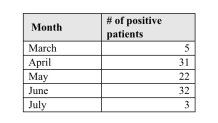Issues concerning system capacity and contributing to the backlog of COVID-19 test results in Texas have been resolved but it’s possible that local health departments may be reporting older and higher-than-normal numbers for several more days, a Texas Department of State Health Services spokesperson says.
Chris Van Dusen, a spokesperson for DSHS, said the state’s system which processes electronic records can now handle more than 100,000 test results a day after an upgrade it received earlier this month. Previously, the system was able to handle up to 48,000.
“Before COVID ever started, we got about less than 2,000 lab reports every day. It was positive reports about cases of tuberculosis and measles and those kinds of things that we get notifications for all the time,” Van Dusen said. “When we started seeing COVID, the requirement was to start reporting all lab results – not just those that are positive. That quickly ramped up, so we’re seeing tens of thousands of lab reports every day.”
Backlogged results stemming from that issue have since been entered into the state’s system and “pushed out” to local health departments, Van Dusen added.
“Those health departments then have to look and reconcile and make sure are these actually new cases that we didn’t know about or are these cases that we were notified through some other way?” he said. “Each local health department has a process to do that checking, so I can’t put an exact time frame on it but we know they’re continuing to do that and make sure those numbers are as accurate as possible.”
At a press conference Sunday regarding two storms inbound for the Gulf Coast, Gov. Greg Abbott took a question regarding the backlog acknowledging the initial limitation of imported tests as one of the primary reasons behind the backlog.
“That limitation has been fixed, and there is no more backlog,” Abbott said. “There may still be some lingering challenges with some of the private labs and being able to give us immediate, updated test results. We are continuing to work with those private labs for a quicker turnaround.”
Abbott added, the data that has now been recorded is “far more accurate than what we had last month and maybe even a couple of weeks ago."
“That data should be very close to being perfectly accurate in the coming weeks and coming months. We’re now to the point of where we have a far more reliable positivity rate as well as a far more accurate number of people testing positive,” he said. “All that said, one very important fact for people to remember is that first, anybody who has tested positive, they would have been provided that information immediately by the health care provider. Second, a very important fact for people to follow as we continue to respond to COVID-19 is the number of people hospitalized who have tested positive for COVID-19. That data is very accurate and very current.”
On Sunday, Dallas County health officials reported 332 additional confirmed cases of COVID-19.
"Of the 332 new cases we are reporting today, 93 came through the Texas Department of State Health Services’ (DSHS) electronic laboratory reporting (ELR) system, with the majority from April, May and June," a press release from the Chief of Staff for Dallas County Judge Clay Jenkins states.

Timothy Bray, Ph.D., director of the Institute for Urban Policy at UT Dallas, said “reassigning” the recent large batches of testing results data from the state to the proper dates could be a critical step from a policy standpoint.
“What I’m talking about is reassigning them off of that Thursday, Friday, Saturday when that big batch came in and put them back on the day where they should have been. Had they been reported correctly, where would they be?” Bray explained. “So that we can correct all of our historical data and get a much better understanding of… maybe we peaked on the same time or maybe we peaked later or earlier once we look at this new data. Maybe the days we were decreasing, we were actually increasing. What we’re looking at in the scientific community, 'Hey did the bar closures make a difference? Did the mask mandate mask a difference?' So, it’s crucial for us to have as accurate as possible count of cases.”
Van Dusen said from a public health standpoint, they are not solely looking at one single data point or a series of numbers. Instead, they look at everything “in concert” to get a clearer picture of what COVID-19 looks like Texas, he said.
“You may see a data point shift over time just due to the volume that we get in every day. As I talked about, all of those contributions… hundreds of hospitals, hundreds of labs, all of the local health departments are providing data all the time… we’re turning it around very, very quickly. When we identify an issue, if there’s something that needs to be updated, we do that as quickly -- we do that as transparently as possible,” Van Dusen said.
Van Dusen added overall, virus transmission is not as low as it was in April and early. The messaging with mask usage and social distancing remains the same, he said.

